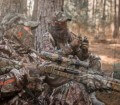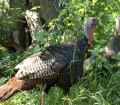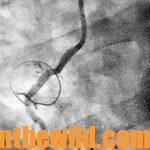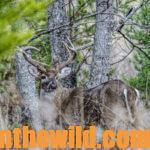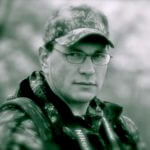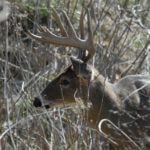John’s Note: At age 16, Preston Pittman of Lucedale, Mississippi, won his first turkey calling championship. When asked how this affected him, he says, “I was a small size growing up, had asthma and chronic nose bleeds and couldn’t compete in most sports. I fell in love with God’s greatest gift, the outdoors. When I won that first contest, it did something to me. I realized I was good at turkey calling.” Today Pittman has won and placed in so many contests that remembering them all is hard, including – the World Turkey Calling Championship, the World Natural Voice Turkey Calling Contest, the World Two Man Team Turkey Calling Contest and numerous others. In 2008, he was inducted into the National Outdoor Hall of Fame. Pittman has hunted across the United States and was the first person to document a Double Grand Slam (two turkeys of each of the four major subspecies of the American wild turkey) in one year. He is on many pro staffs, such as Longleaf Camo (http://www.longleafcamo.com), Muzzy (http://www.muzzy.com), Scent Lok (http://www.scentlok.com) and MOJO Outdoors (http://www.mojooutdoors.com). “I’m just a country boy producing a product (http://www.pittmangamecalls.com) that I believe in and know it works.”
As Preston Pittman and I stood on the edge of an old pasture that dropped off into a partially- flooded hardwood bottom, I listened intently for a turkey to gobble just at the beginning of daylight. First, Pittman tree called. When we didn’t hear a turkey answer after about 5 minutes, he gave some loud yelping, and three toms sounded off. One gobbler was on the edge of a slough 300 – 400 yards away to our left. A second gobbler that talked from the timber directly in front of us seemed to be closer than the first gobbler. The third longbeard was off to our right, gobbling just on the edge of our hearing. We waited and listened for perhaps 10 minutes before Pittman called again. This time we could tell by their gobbling that the birds were on the ground. The turkey that was about 300 yards off to our left and the center gobbler started coming to us.
We were in a perfect position to bag one of those wily, ole birds. We had set-up a decoy in the middle of an old logging road in front of us. Then we backed off 15 – 20 yards from the decoy. I sat down next to a large tree, and Pittman was behind me a little to my left. We hoped both gobblers would race to what they thought was a hen, and I’d be able to get a shot at one of them. As the hunt progressed, the turkey to our left started gobbling a lot as he came to us, but the turkey that was just out in front of us ceased gobbling. So, we knew the gobbler that was headed in our direction was more than likely the boss gobbler.
 Although I’ve been hunting turkeys for more than 50 years, I could feel the adrenaline racing through my system, and my heart started pounding. I nestled the stock of my gun squarely into the pocket of my shoulder and placed my cheek on the stock where I had a full view with my turkey scope sitting atop my Remington 1187. Slightly off to my left was about 6 – 8 inches of water in a slough about 60-yards long. In front of me were two trees – each about 12 inches in diameter with some brush in front of them. Because Pittman was sitting to my left, he had a better view of the slough, and nothing blocked his view.
Although I’ve been hunting turkeys for more than 50 years, I could feel the adrenaline racing through my system, and my heart started pounding. I nestled the stock of my gun squarely into the pocket of my shoulder and placed my cheek on the stock where I had a full view with my turkey scope sitting atop my Remington 1187. Slightly off to my left was about 6 – 8 inches of water in a slough about 60-yards long. In front of me were two trees – each about 12 inches in diameter with some brush in front of them. Because Pittman was sitting to my left, he had a better view of the slough, and nothing blocked his view.
“That longbeard walked up on the left side of the slough and came within about 40 yards of where we were sitting,” Pittman told me later. “Then he turned around and went back the way he had come from and appeared on our side of the slough.” The gobbler gobbled at the back end of the slough and gobbled again as he closed the distance to us. But I never saw him. When he gobbled about 30 yards from me straight in front of me, I tightened the grip on my gun, pushed the safety off and started looking for the turkey. I had one eye in the scope, and I had my other eye looking at the woods in front of me. The gobbler was directly behind the two trees with the brush in front of them. All he had to do was step to his left or right, and I could take the shot.
Less than 100-yards away, we heard hens beginning to call to the gobbler. I could tell the turkey was focused on Pittman’s calling behind me. “The gobbler was less than 40-yards from you when he gobbled that last time,” Pittman said later. “He gobbled straight at the hen decoy and looked at her, however, she didn’t move. Then instead of going left or right, he made a 180-degree turn and walked straight back the way he had come, angling in the direction where the hens were yelping and walking. I knew you couldn’t see him. I could’ve shot him, but the shot would have been too close to you for comfort.”
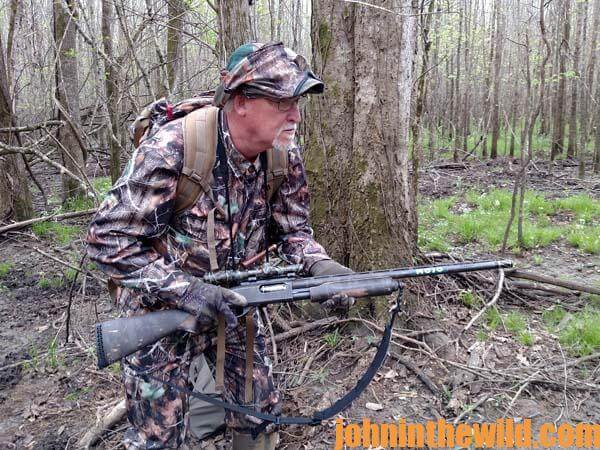 “That scenario is what I call learning a turkey. That bird had a big heavy beard. I believe he was at least a 4-year-old bird. He was smart enough to know that if that hen didn’t turn and come to him when he gobbled at her, something was wrong, and his safest route of travel was to go back the way from where he’d come. If I had a chance to hunt that turkey again, I wouldn’t use a decoy. I’d make that gobbler come find me.”
“That scenario is what I call learning a turkey. That bird had a big heavy beard. I believe he was at least a 4-year-old bird. He was smart enough to know that if that hen didn’t turn and come to him when he gobbled at her, something was wrong, and his safest route of travel was to go back the way from where he’d come. If I had a chance to hunt that turkey again, I wouldn’t use a decoy. I’d make that gobbler come find me.”
I’ve hunted without decoys most of my life, and I’ve hunted with decoys. I know that turkeys won’t always come to a turkey decoy for several different reasons, but this was the first time I totally understood why an older gobbler would be more reluctant to come to a decoy than a younger gobbler.
The area we were hunting is hunted fairly heavily by turkey hunters. More than likely, that gobbler has seen another turkey decoy. Instead of going to the left or to the right, he’s learned that when he spots one of those decoys, the safest way to get away from what he perceives as danger is to go back the way he came. So, the lesson learned here is: if you know you’re hunting an older gobbler in an area that has had some turkey hunting pressure, don’t use a decoy. Or, if you have a similar experience to the one that Pittman and I had, you know that more than likely, you can go into that same area, not use a decoy and have a reasonably good chance of taking that ole bird that has fooled you the first time you’ve met him.
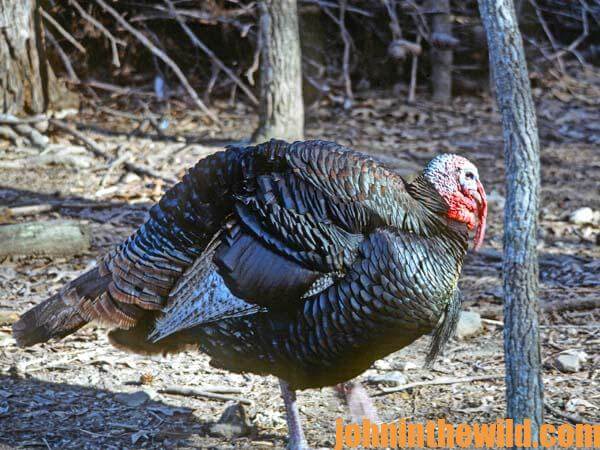 I told Pittman, “We had a perfect hunt. We heard three birds gobble, and we had two turkeys coming to us. When the younger bird got close to us, he recognized the other turkey as being a dominant gobbler. So, he quit gobbling and yielded to the older, bigger bird. This longbeard came within shooting distance and nearly blew my hat off with his last gobble. He spotted the decoy and left without a shot being fired. We had a great hunt; we tested a big, ole smart gobbler, and on this day, the turkey won the game.” A perfect hunt doesn’t have to end with a gobbler in your turkey vest – but it’s nice when it does.
I told Pittman, “We had a perfect hunt. We heard three birds gobble, and we had two turkeys coming to us. When the younger bird got close to us, he recognized the other turkey as being a dominant gobbler. So, he quit gobbling and yielded to the older, bigger bird. This longbeard came within shooting distance and nearly blew my hat off with his last gobble. He spotted the decoy and left without a shot being fired. We had a great hunt; we tested a big, ole smart gobbler, and on this day, the turkey won the game.” A perfect hunt doesn’t have to end with a gobbler in your turkey vest – but it’s nice when it does.
You can learn more about Preston Pittman and how he hunts on his Facebook page at https://www.facebook.com/pittmangamecalls/?fref=ts and on his webpage at www.pittmangamecalls.com/
To see John E. Phillips’ Kindle eBook, “How to Hunt Turkeys with World Champion Preston Pittman,” click here at http://amzn.to/144Irn5.
To learn more about turkey hunting from the masters, get these Kindle eBooks and print books by John E. Phillips, including: “The Turkey Hunter’s Bible (available as an eBook or in paperback),” “PhD Gobblers: How to Hunt the Smartest Turkeys in the World,” “Turkey Hunting Tactics,” (also available in an audio book from http://www.audible.com/pd/Self-Development/Turkey-Hunting-Tactics), “The 10 Sins of Turkey Hunting with Preston Pittman” and “Outdoor Life’s Complete Turkey Hunting.” Click here to get these books.
To get John’s book, “The Turkey Gobbler Getter Manual,” for free, go to www.johninthewild.com/free-books to download.

